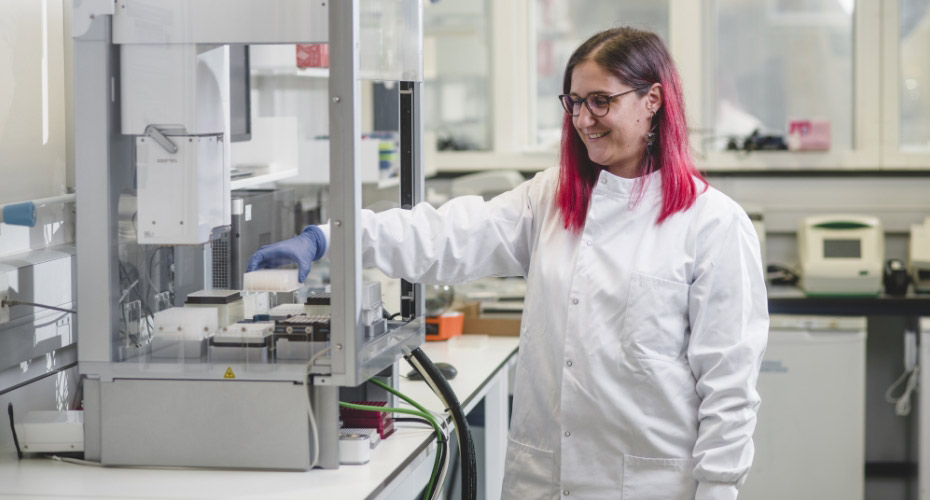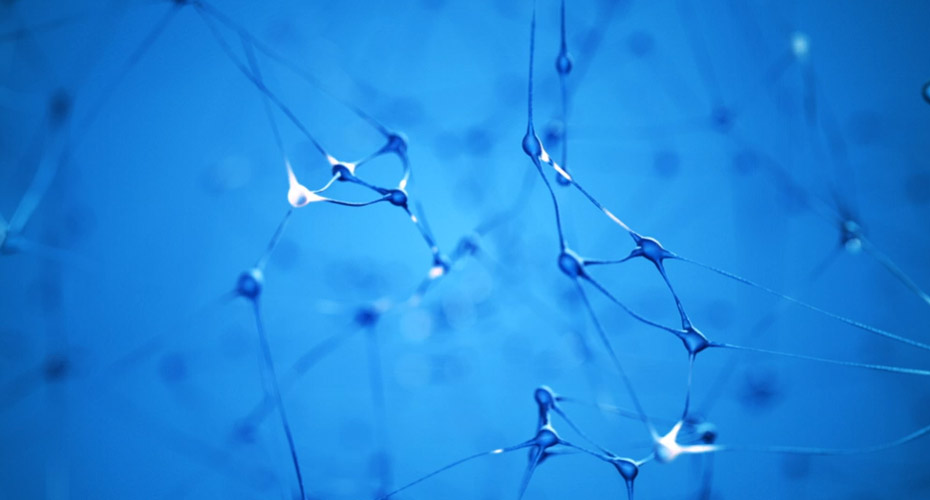Case study:
Technological advances in psychiatric disease treatment and prevention
Our lack of knowledge around the workings of the brain means we know very little about brain disorders, a set of diseases that have particularly devastating consequences.
Academics at the University of Exeter are performing pioneering research into these largely understudied conditions, including motor neurone disease, Parkinson’s disease, dementia, and schizophrenia, studying the underlying causes of disease and progressing the hope of finding new treatments.
The teams specialise in innovative use of cutting-edge technologies – allowing them to discover, interrogate and test disease mechanisms in a way that has never before been possible. Jonathan Mill, Professor of Epigenomics at the University of Exeter, said: “Cumulatively, these neurological diseases make a massive contribution to the global burden of disease, and their impact will become even more profound as our population ages. At Exeter, we have expertise in both basic and translational neuroscience with our researchers aiming to increase our understanding of these terrible disorders and reduce ultimately reduce their impact.”
The University of Exeter has invested in state-of-the-art facilities for neuroimaging, genomics and stem cell research. The recent award of the new Exeter NIHR Biomedical Research Centre means that Exeter researchers are ideally placed to translate their neuroscience discoveries into benefits for patients.
Professor Mill specialises in characterising genomic variation in the human brain, using cutting-edge methods. His team generates maps in the brain detailing the differential expression of genes across the different cell types in the central nervous system and using these annotations to ask questions about the mechanisms involved in disorders such as schizophrenia, Alzheimer’s disease and motor neurone disease. Professor Mill said: “The brain is comprised of a mass of different type of cells. Until now, it has been very hard to identify which of these is implicated in specific diseases. We’re using novel methods to “purify” these different cell populations, characterising which genes are activated at different points in development and identifying which genes are not functioning properly in disease. These studies are identifying a huge number of novel genes that might be important in the disease process, elucidating new mechanisms and identifying potential drug targets.”
The team is also using these genomic maps of specific brain cell-types to develop a test to identify early signs of neurodegeneration. Collaborating with the Exeter Sequencing Facility, the team’s novel assay can detect genetic material originating from the brain in circulating blood, providing an early indicator of disease. For any future treatments to be effective, we will need to intervene as early as possible.
At the University of Exeter’s Mireille Gillings Neuroimaging Centre, early disease identification is one of a range of research areas for Dr Heather Wilson, Senior Research Fellow and Lead of Imaging Methodology. The facility incorporates cutting-edge PET/CT and MRI scanners to support multidisciplinary clinical research and clinical trials. Importantly, these scanners are specifically dedicated to clinical research. “We have among the best scanning technology in the country, allowing us to conduct world-leading molecular imaging research in brain disorders to help drive forward breakthroughs in understanding disease aetiology, pathophysiology, how patients respond to treatments and biomarker discovery,” Dr Wilson said.
The technology means the University’s Neurodegeneration Imaging Group can understand some of the earliest disease related changes in living patients with neurodegenerative disorders including Huntington’s, Parkinson’s and Motor Neuron Disease. The group’s large portfolio of research studies is at the forefront of innovations in the identification of novel targets for pharmacotherapy, biomarker discovery and understanding disease mechanisms. The ability to reliably identify patients early in the disease, even in preclinical stages, and track their progression, using in vivo markers, could help to provide temporal and spatial maps of disease pathology. Molecular neuroimaging provides a unique opportunity to identify patients early when therapeutic intervention might be most effective, and to improve the stratification of patients into targeted clinical trials based on underlying molecular pathology, as well as providing outcome measures with greater sensitivity.
The team can identify new drug targets and examine the effects of a particular drug to see how it behaves at a molecular level, helping to accelerate drug development. Dr Wilson said: “We’re investigating new biomarkers, and new targets for disease modifying therapies in diseases including Parkinson’s and Motor Neurone Disease, and we’re running clinical trials testing the effects of different drugs. This technology can be applied to a range of other brain disorders, including schizophrenia.
“Our state-of-the-art Neuroimaging Centre enables interdisciplinary collaborations with academic and industry partners to bridge the gap between basic and clinical research driving faster translation into drug development and clinical applications for patients.”
This interdisciplinary approach as at the heart of the University of Exeter’s Living System’s Institute. Dr Akshay Bhinge, Senior Lecturer in Clinical and Biomedical Science, specialises in stem cell research, which seeks to find new treatments that will work in humans more effectively than animal research has so far produced. “Animal and human cells are similar, but they’re not the same,” said Dr Bhinge. “Our method uses human induced pluripotent stem cells – that’s an incredibly powerful tool which means we can take skin or blood cells from a patient and turn these cells into a stem cell, then create any kind of cell we want, including different brain cells. We’re working with human brain cells, and we can look in minute details at how those cells behave, and how that contrasts whether they’re affected by disease.”
In motor neurone disease, the techniques have revealed that neurones look and connect differently than those generated from people without the disease. “These are live neurons, so we can follow their life process in a dish,” said Dr Bhinge. “We can see how they behave when exposed to different drugs or genetic perturbations, which is a promising route to finding new treatments for disease.”
The lab utilises genomics and microscopic techniques, and results are cross referenced with patient data. “We have a critical mass of outstanding researchers across different disciplines working on complex neurologicaldisorders, which generates very exciting outcomes and opportunities,” Dr Bhinge said.
Hear more from our Neuroscience academics

Jonathan Mill
Professor of Epigenomics; Head of Department, Clinical & Biomedical Sciences

Heather Wilson
Senior Research Fellow, Imaging Methodology Lead

Akshay Bhinge
Senior Lecturer in Clinical and Biomedical Sciences
Jonathan Mill
Professor of Epigenomics; Head of Department, Clinical & Biomedical Sciences
My research explores the factors controlling transcriptional regulation in the central nervous system, with a focus on the role of epigenomic variation in disorders of the brain including schizophrenia, depression, Alzheimer’s disease and other types of dementia. We use cutting-edge sequencing methods to profile the different specific cell-types in the human brain, identifying the molecular mechanisms which underpin interactions between DNA sequence variation and the environment. Our aim is to identify novel targets that might inform the development of new treatments for mental illness and dementia, and facilitate the development of diagnostic tests for the early detection of neurodegeneration.
Profile page
Jonathan Mill
Professor of Epigenomics; Head of Department, Clinical & Biomedical Sciences
My research explores the factors controlling transcriptional regulation in the central nervous system, with a focus on the role of epigenomic variation in disorders of the brain including schizophrenia, depression, Alzheimer’s disease and other types of dementia. We use cutting-edge sequencing methods to profile the different specific cell-types in the human brain, identifying the molecular mechanisms which underpin interactions between DNA sequence variation and the environment. Our aim is to identify novel targets that might inform the development of new treatments for mental illness and dementia, and facilitate the development of diagnostic tests for the early detection of neurodegeneration.
Profile page
Heather Wilson
Senior Research Fellow, Imaging Methodology Lead
I am a Senior Research Fellow in the Neurodegeneration Imaging Group, and Imaging Methodology Lead at the Mireille Gillings Neuroimaging Centre. My research focuses on the development and implementation of novel neuroimaging techniques with translational applications in neurodegenerative diseases such as Parkinson’s, Huntington’s, and Alzheimer’s disease. My work utilised a multifaceted approach, employing PET, MRI, and SPECT methodologies alongside genetic, digital, and clinical data, aiming to understand disease mechanisms, aid early identification, track disease progression, and identify new targets for pharmacotherapies. Through my research I hope to help disentangle disease related molecular pathways, starting from preclinical stages, and to help advance biomarker discovery and drug development striving towards disease modifying therapies for patients.
Profile page
Akshay Bhinge
Senior Lecturer in Clinical and Biomedical Sciences
We aim to understand why neurons die in neurodegenerative diseases such as Amyotrophic Lateral Sclerosis and Dementia. By applying CRISPR-Cas9 genome editing to patient-derived stem cells, we generate clinically relevant human models of neurodegeneration. Using a combination of genomics, bioinformatics, and high-throughput functional screens, we interrogate these models to elucidate the regulatory networks that drive neuronal death. Our ultimate goal is to identify key disease drivers that can be used to develop therapies to halt or even reverse the relentless neuronal loss.
Profile page

Impact-driven research for healthier young minds
The University of Exeter’s neuroscience community is making great strides in understanding the mechanisms of how brains develop and how stress occurs in our youth and the impacts it has in later life.
Find out more

Advancing translational research in neurological disorders
The University of Exeter is making world-leading advances in understanding how our brains develop and function, and what changes occur in some of our most devastating diseases.
Back to neurological disorders research









